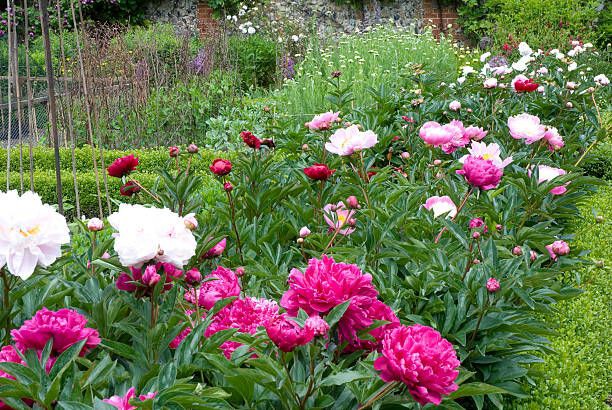Yes, you do need these gorgeous, timeless flowers in your garden!
Peonies are the queens of the flower garden! With lush flowers, saturated colors, and a long life (these perennials can live up to 100 years!), peonies get all the attention when in bloom. Depending on the variety and weather conditions each year, they bloom from early May to late June. “Peonies are a beautiful, old-fashioned perennial that’s been popular in gardens since Victorian times,” says Jeff Jabco, director of grounds and coordinator of horticulture at The Scott Arboretum of Swarthmore College. “They’re a tough plant that doesn’t need coddled once established, and they don’t have to be dug up and divided every few years like other perennials.”
Here’s what else you need to know about growing peonies in your garden:
What kinds of peonies can you plant?
Peonies grow in USDA Hardiness zones 4 to 8 (check yours here), so make sure you choose one that can survive winters in your area. They need a period of winter dormancy, so they don’t grow in hot climates, says Jabco. There are three main types: Herbaceous, tree, and Itoh peonies. Herbaceous peonies get a few feet tall and die back to the ground every winter, returning with new foliage next spring. Woody, or “tree” peonies are a woody shrub that reaches 6 to 7 feet tall with loads of large flowers. Itoh peonies, developed in the 70s and 80s, are a hybrid of herbaceous and tree peonies. They die back to the ground, but the large blossoms resemble those of tree peonies. Many peonies have wonderful fragrances, too, but read the plant tag or description so you know what you’re buying. Popular varieties to try include Festiva Maxima, Sarah Bernhardt, Lorelei, and Madame de Verneville.
When should I plant peonies?
Plant peonies in the fall. “Peonies have thick, fleshy roots, but in the fall, they put out tiny feeder roots, which absorb water and nutrients efficiently, so it’s really the best time to plant them,” says Jabco. But if you happened to pick up a potted peony at the nursery in summer, don’t wait to plant. Get it in the ground as soon as possible.

How do I plant peonies?
Pick a spot with room to spread; peonies don’t like to be crowded or compete with other perennials for nutrients, says Jabco. Peonies need full sun to bloom, which is about 6 or more hours a day. Make sure they're in well-drained soil because they don’t like standing water. They’ll grow in most soil types, even clay as long as it drains well, but they prefer light, rich soils. If you get a bare root (no soil attached), which resembles a skinny sweet potato, plant it just 2 inches below the soil line, says Jabco. Potted peonies go in the ground in a hole about twice as wide as the pot, even with its depth in the pot. When planting, add some organic matter, such as compost, and a slow-release 10-10-10 organic fertilizer, according to package instructions. Be patient! Some peonies will flower the first year, while others may take a few years to get established and bloom.
How do I care for peonies?
Some peonies need staking if their heads get too heavy and flop over, but there are varieties that maintain a more compact shape that won’t require support. Once established, fertilize your plants in the fall and again in the spring as the shoots come out of the ground. Water during droughts, especially young plants (one to two years old). After peonies bloom, deadhead, or remove the spent flowers, so they won’t put energy into developing seed pods. In the fall when the foliage is brown and dry after the first hard frost, cut herbaceous and Itoh peonies back to the ground. Remove and dispose of all dropped foliage from beneath any kind of peony.
Do peonies need ants to flower?
Nope! It’s an old myth. The ants simply are there to enjoy the sweet, sticky nectar from the buds. Just shake ants off or rinse blossoms under cool water if you plan to cut and bring indoors.
When should I cut my peonies to display indoors?
If you cut peonies after they’re already open, they’ll only last a few days. “Instead, cut them before the bud opens but when there is some color, says Jabco. “It’s called the ‘marshmallow’ stage because the bud feels soft but not squishy.” Do it in the morning, when they’re full of moisture.
Once inside, interior designer Amanda Nisbet says to put them in a clean vase with at least 3 to 4 inches of room temperature water. Remove any foliage that falls below the water line. Add water regularly, and clean and refill the vase and re-cut the stems every few days to maximize vase life.
The rate at which the blooms open depends on the temperature of the room (warm room= faster opening). If you’re having a dinner party that evening, strip the foliage and add 6 inches of warm water to the vase to help them open. Keep them in a warm-ish room, but not in direct sunlight. Need to slow things down? Place them in the fridge, but away from fruits and veggies, which speed up the aging of the blooms. If you have room, you also can put the whole vase inside your fridge.